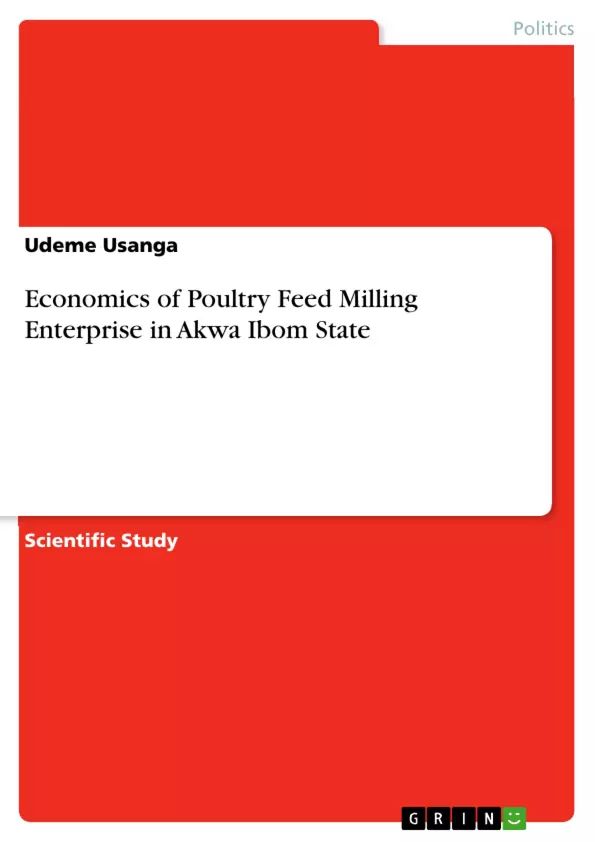Formulated feeds account for the major operating costs in the semi-intensive and intensive pig and poultry (monogastrics) industry. These costs may account for as much as 60 - 80 % of total production cost. Although the production of conventional livestock has risen steadily over recent years, a major constraint to its expansion is an inadequate feed supply. The poor quality of the feeds currently available to the market generate high mortalities, stimulates low productivity of livestock and as a consequence, produces a low rate of return on investment (ROI) to farmers. An efficient feedmill industry is therefore crucial to the sustainability of viable livestock and poultry production enterprises. Poultry feeds account for over two-thirds of all the manufactured animal feeds; therefore, any attempt at studying efficient allocation of resources and measuring profitability on the farm level represents an important source of achieving the supply of animal protein to the teeming population and growth in the economy. This study was conducted in Akwa Ibom State to analyze the profitability of poultry feed mill enterprise. Data were collected from 50 respondents in ten (10) Local Government Areas of the state, using simple random technique between January and June 2013 with a well-structured questionnaire. The data were analyzed using Gross Margin Analysis. It was found that the feed milling enterprise is profitable with a Gross Margin of N102, 186. 50 and a Net Returns of N60, 272.67. The Benefit Cost Ratio (BCR), was 1.14:1 The results also revealed that high cost of inputs, high cost of labour, high cost of assets (processing equipment) and lack of access to credit facilities, were the major constraints affecting poultry feed production in the area.
Inhaltsverzeichnis (Table of Contents)
- Abstract
- Introduction
- Poultry Feeds Production
- Components of Poultry Diets
- Methodology
- Poultry Rations composition
- Results and Discussions
- Conclusion and Recommendation
Zielsetzung und Themenschwerpunkte (Objectives and Key Themes)
This study aims to analyze the profitability of poultry feed mill enterprises in Akwa Ibom State, Nigeria. It investigates the production costs, sales prices, and profitability of poultry feeds in the region, considering factors like feed ingredient composition, market prices, and the impact of using locally available resources.
- Profitability of poultry feed mill enterprises in Akwa Ibom State
- Impact of feed ingredient composition and cost on poultry production
- Comparison of local feed production with commercial brands
- Importance of utilizing locally available feed resources for sustainable poultry production
- Challenges and opportunities facing the poultry feed industry in the region
Zusammenfassung der Kapitel (Chapter Summaries)
- Abstract: The study highlights the importance of efficient feed production in poultry farming and aims to assess the profitability of poultry feed mill enterprises in Akwa Ibom State. It acknowledges the challenges associated with feed quality and cost in the region.
- Introduction: The introduction provides an overview of the livestock and poultry industry in Nigeria, focusing on the significance of poultry production and the use of formulated feeds. It discusses the challenges faced by smallholder farmers in Akwa Ibom State due to high feed costs and the need for locally available feed resources.
- Poultry Feeds Production: This section discusses common techniques used in feed formulation, including Pearson Square Method, Linear Programming, Non Linear Programming, and Trial and Error Method. It emphasizes the popularity of the Trial and Error method in Nigeria.
- Components of Poultry Diets: This chapter delves into the essential components of poultry diets, highlighting the importance of protein, vitamins, minerals, and metabolizable energy (ME). It examines the sources of these nutrients and their impact on poultry health and performance.
- Methodology: This section outlines the research methodology employed in the study. It describes the data collection process, including the use of questionnaires, cost route approach, and market surveys. The study involved 50 respondents from 10 Local Government Areas in Akwa Ibom State.
- Poultry Rations Composition: This chapter discusses the different types of poultry feeds, including chick mash, grower mash, and layer mash. It provides details about the composition and nutritional requirements of each type of feed.
- Results and Discussions: This section presents the key findings of the study, including the cost of production for different types of poultry feed, the profitability analysis of local feed mill enterprises, and a comparison with commercial feed brands. It highlights the benefits of utilizing local feed resources and the need for improved feed formulation techniques.
Schlüsselwörter (Keywords)
Key focus topics of this research include poultry feed production, profitability analysis, feed formulation techniques, local feed resources, poultry nutrition, cost of production, market prices, and sustainable poultry farming in Akwa Ibom State, Nigeria.
- Quote paper
- Udeme Usanga (Author), 2023, Economics of Poultry Feed Milling Enterprise in Akwa Ibom State, Munich, GRIN Verlag, https://www.hausarbeiten.de/document/1387597


